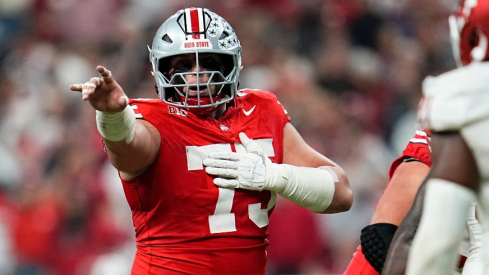
Ohio State's relatively paltry point output against Michigan State obscures a solid performance against a good Spartan defense. Ohio State recorded only two three and outs, while conducting five drives with six plays or more. Ohio State thus effectively controlled the pace of play and field position throughout the game. Simply put, Ohio State's output was limited by three turnovers in Spartan territory. But any time you win on the road while losing the turnover margin must be considered a success. Though OSU's offensive performance will likely be uneven throughout the year, the coaching staff has identified the ingredients for this team's success, creating a consistent framework for this offense moving forward.
Michigan State: Loaded for Bear
As expected, Michigan State adopted an aggressive style that focused upon attacking Ohio State's inside zone read. Michigan State generally operated from their 40 over defense with their Will linebacker walked over the slot receiver.

The Spartan Will linebacker's role was not to cover the slot receiver, however. Instead, he was tasked with accounting for Braxton Miller on the zone read, allowing the defensive end to crash the zone play. In essence, the Spartans ran a constant scrape exchange.
Michigan State also regularly featured two specific blitzes. The Spartans brought their Mike linebacker through the weakside 'A' gap to attack the inside zone's bubble. They also brought their boundary corner when OSU had a single receiver to his side.
The Buckeye Response: Working Within Our Framework
Ohio State made subtle blocking adjustments that allowed them to run their base plays against this approach. The Buckeyes began the game by using Zach Boren to arc block, moving past the crashing defensive end to lead block for Braxton Miller at the second level.
The Buckeyes then aligned Boren to the halfback side and had him block the backside end, with Miller reading the Will 'backer.
Finally, the Buckeyes also utilized the 'midline' zone read for the first time this season. With the midline, the quarterback simply reads the defensive tackle rather than a defensive end. It takes advantage of a defensive tackle's lack of familiarity with being read and negates a defense playing scrape exchanges. OSU combined the midline read with a fold-block by the guard and tackle, creating a nice crease for Miller.

Ohio State also featured a panoply of wide receiver screens to Corey Brown that they heretofore had not shown. Though they did not result in excessive yardage, they kept the Spartan defense honest in their pre-snap alignment, providing the OSU running game room to breathe. In short, Urban Meyer and Tom Herman's goal was to adapt to ensure that OSU could still execute their base offense against the Spartan defense.
Inside Zone and QB Outside Lead Zone: Love and Marriage...
Perhaps nothing better reflects Ohio State's effort to remain within their offensive comfort zone than the use of the ying and yang of inside zone and QB outside lead zone. Meyer's goal is to cause defensive end confusion. The QB outside zone as a change-up to inside zone does precisely that. The play is run from the same formation. But it turns the defensive backside against inside zone in to the playside against outside zone. Mapped together they look like this:

Specifically, the use of lead outside zone exploits the scrape exchange. The crashing defensive end takes himself out of the play and the lead back lets the linebacker's momentum take him to the sideline, creating a seal for Miller. In the slow motion clip, watch how 44 is completely removed from the play by attacking against inside zone.
The benefit of these paired plays was particularly apparent on Ohio State's game-sealing drive, where the Buckeyes went back and forth between the two runs.
'HAM AND EGGING IT'
The above is a good example of what Urban Meyer meant when he said this offense is "ham and egging it" (for golf fans out there) to win games. The coaching staff believes that the offense has specific areas where it can succeed. But if they move beyond that they may struggle. Defenses also know what those areas are. The coaching staff must therefore work within the parameters of what they believe this team can do successfully to nonetheless constrain the defense.
Michigan State helped illuminate both aspects. The offense is limited by youth and a short list of playmakers. Braxton Miller is uber talented and a dynamic runner. But he is also still learning and inconsistent in his reads in both the running and passing game. He can drop a dime like he did on the perfectly thrown four verticals route to Devin Smith but also make incorrect decisions that lead to zero or negative gains.
For example, on the interception, OSU ran a snag route and rather than take the open flat pass, he forced the ball to the snag. This also leads to negative plays in the run game. As Meyer stated in his press conference, the coaching staff counted 8 instances where he made the incorrect read. For instance, inverted veer is continually leading to negative plays, as Miller refuses to keep the ball even with such a wide open gap that Marcus Hall does not have anyone to block.
OSU is also limited in playmakers. The Buckeye coaching staff and Miller trust Brown to work from the slot and Devin Smith as a deep threat. So the coaching staff likes putting them to the same side and working combinations between the two like snag and snatch. It also keeps things relatively simple for Miller in the pass game. Similarly, the Buckeyes have two solid backs in Jordan Hall and Carlos Hyde, but neither is a 'game breaker' that an opposing defense will plan around.
But Ohio State does have areas where they succeed. Smith and Brown have emerged as reliable threats, something Meyer was not sure he had on the outside during spring practice. The offensive line has become a clear strength. Reid Fragel rightly deserved the credit he received for his last two performances. But Ohio State's clear strength is the left side of the offensive line where Jack Mewhort and Andrew Norwell are playing at an all-league level. Norwell in particular road-graded Michigan State's interior line all game long.
And Boren is a huge asset as a lead blocker, literally calling upon Ohio State to run behind him on the game-clinching drive. Hyde and Hall are able to rack up consistent yardage that keeps Ohio State ahead of the chains. And Miller is a game-changing threat.
From those elements Ohio State exhibited the resulting approach against Michigan State, perhaps the first team they felt they needed a game plan without 'practicing' other areas. OSU was a run-heavy team, combining the inside zone with Miller attacking the edge. When Ohio State needs a play, they will eschew any reads and simply run Miller on direct lead runs. The passing game is complementary. The Buckeyes rely on Brown to work underneath on option and follow routes to gain first downs and on Smith to attack downfield.
Defenses will continue to attempt to take away these aspects, particularly in the run game. But Meyer's ultimate point is that OSU must stick to their game plan because they simply do not have the ability to dramatically change course and throw 40 times. The Buckeye passing game is too inconsistent, getting OSU stuck behind the chains. In other words, Ohio State must stay inside their lanes to succeed—they do not have a lot of variety. The Ohio State coaching staff's job is instead to make subtle adjustments within what OSU does well to constrain the defense's tendencies, as the Buckeyes did against Michigan State.
Nebraska: Pattern Matching is My Thing
Q. Can you talk a little about Nebraska?
COACH MEYER: The combination coverages are hard to figure out. They get no drops. When I pause the film sometimes when the quarterback is in the top of his drop, they get no depth. They're looking to receivers. They're all pattern match, as opposed to zone coverage teams do this. They don't move. They just read in routes.So the thing that's difficult about that, a lot of times their base stuff doesn't work against that. So we have to try some new things. I don't want to say immature team, but we're young. My head's kind of spinning right now because I just walked out of a meeting room that we're going to have to do some things that we haven't done.
Ohio State's need to stay within its capabilities will be equally applicable against Nebraska. As Meyer discussed in his presser, one challenge Nebraska poses is the employment of 'pattern matching' in the secondary. As discussed, pattern matching is the nouveau trend for defenses at all levels. At its simplest, pattern matching is effectively the equivalent of a match-up zone in basketball. Pattern-matching defenses generally work from a cover-3 or cover-4 shell (Nebraska generally operates with 2-high safeties). The defense will divide the field in half. Teams will have 2-3 routes per side. So the No. 1 defender (corner) is responsible for the No. 1 outside route, the safety or slot defender the No. 2 route, and the linebacker the No. 3 route to that side. If the number 1 receiver goes vertical or goes outside, the corner will cover him and it will look like man coverage. But if that receiver goes inside, the corner will pass him off to the number 2 defender. As patterns are distributed, the corner will expect that someone will replace that receiver. In other words, the corner is responsible for the outermost receiver to his side.
The seam defenders have the more difficult duty. They will play man coverage on the No. 2 receiver going vertically, but if No. 2 breaks inside he will pass him off to the person responsible for the innermost route.

As Meyer stated, the upshot for Ohio State is that they have not played a pattern-matching team and will thus have to feature different route combinations, a new task for a team that has tried to stay within a few core concepts. But every coverage has weaknesses and pattern matching is no different. Against pattern matching, the goal is to hold the seam player in place with your No. 2 receiver, and then outflank the remaining coverage. Indeed, even though OSU may not have faced a pattern-matching defense, Meyer has long done so, particularly in the form of Nick Saban, one of the pioneers of the concept. Meyer therefore has base pass plays against this look.
One such play is Houston. The No. 2 receivers runs a seam route, guaranteeing that the seam defender will take him in man coverage. No. 1 and 3 then run a simple curl-flat combination, creating a high-low on the cornerback in his area. Theoretically, the inside linebacker is responsible for No. 3, but he should not be able to beat your 3 receiver to the flat. Ohio State will be able to rely upon one staple pass play, snag. Like Houston, this play floods one side of the field, providing a 3-on-2 advantage. The corner route holds the No. 2 defender, with the snag route working underneath.

Generally speaking, though, Nebraska will try to force Braxton Miller and the Ohio State offense to move out of its comfort zone in the passing game. But Nebraska's pattern matching also opened large lanes for Miller last year on QB draws, so expect to see plenty of delayed QB runs from the Ohio State offense.

